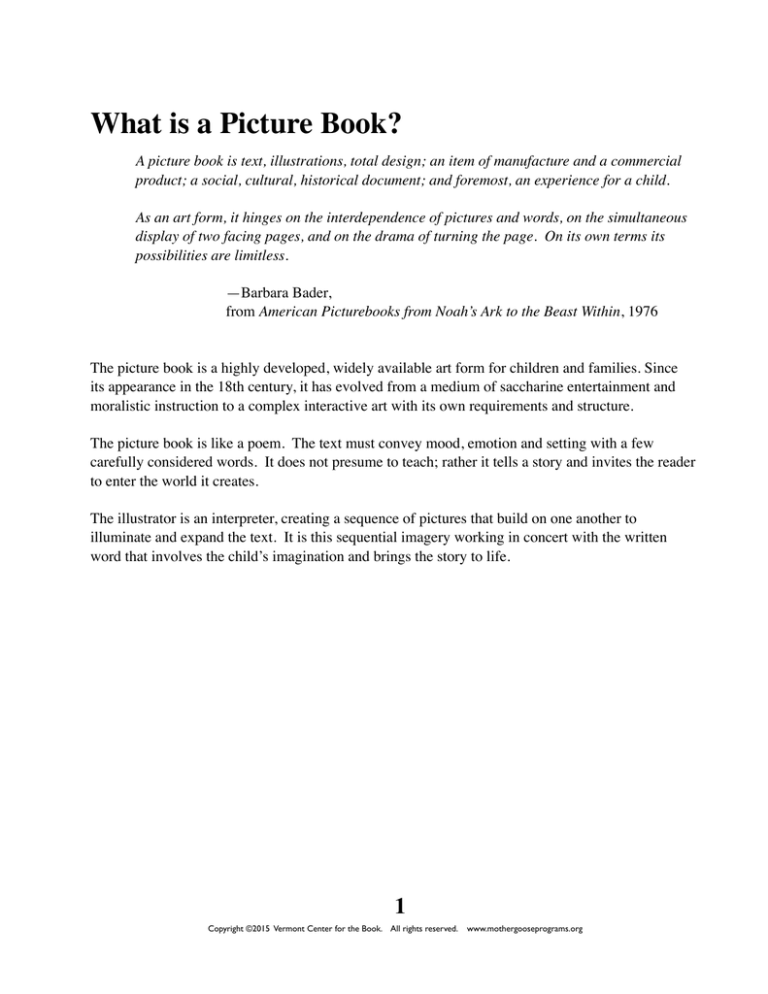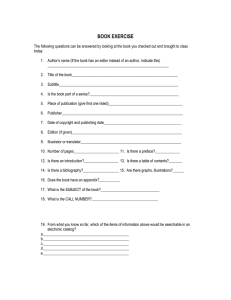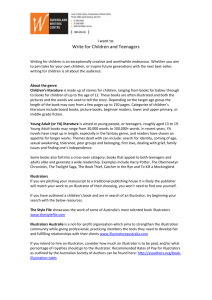
What is a Picture Book?
A picture book is text, illustrations, total design; an item of manufacture and a commercial product; a social, cultural, historical document; and foremost, an experience for a child.
As an art form, it hinges on the interdependence of pictures and words, on the simultaneous display of two facing pages, and on the drama of turning the page. On its own terms its possibilities are limitless.
—Barbara Bader,
from American Picturebooks from Noah’s Ark to the Beast Within, 1976
The picture book is a highly developed, widely available art form for children and families. Since
its appearance in the 18th century, it has evolved from a medium of saccharine entertainment and
moralistic instruction to a complex interactive art with its own requirements and structure.
The picture book is like a poem. The text must convey mood, emotion and setting with a few
carefully considered words. It does not presume to teach; rather it tells a story and invites the reader
to enter the world it creates.
The illustrator is an interpreter, creating a sequence of pictures that build on one another to
illuminate and expand the text. It is this sequential imagery working in concert with the written
word that involves the child’s imagination and brings the story to life.
1
Copyright ©2015 Vermont Center for the Book. All rights reserved.
www.mothergooseprograms.org
Exploring Picture Books
Suggestions for discussion
This page and those that follow include many suggestions for ways to talk about the writing,
illustration and design of picture books. Some topics may be more geared to older age groups. You
will also find examples of text-dependent questions in the activities section of this guide.
What makes a picture book “work”?
In a successful picture book, text and illustration work together to make an interactive whole that is
greater than the sum of its parts.
A picture book begins with an idea. Sometimes this idea is in words and sometimes it’s in pictures.
What do authors and illustrators do to turn an idea into a book? Do Red Clover readers think the
process is easier if the same person writes and illustrates a book? Why or why not? Which books on
the list are written and illustrated by one person? Which ones are done by two or more people?
Authors usually do not have a chance to tell illustrators how they would like to have their books
illustrated. Why do you think this happens this way? If you were the author, would you like to tell
the illustrator what you wanted? If you were the illustrator, would you want the author telling you
how to do the illustrations? Why?
Who works behind the scenes?
• An editor helps the author by suggesting ways to improve the text.
• A book designer (or an art director) decides how the book will look by choosing its size and shape,
the color and type of paper and the type styles or fonts for the text. He or she also designs the cover
and the layout of the pages.
• A publisher decides which books should be published by his or her company.
Further resources:
Bang, Molly Garrett. Picture This: How Pictures Work. SeaStar Books, 2000.
Christelow, Eileen. What Do Authors Do? Houghton Mifflin, 1997.
Christelow, Eileen. What Do Illustrators Do? Houghton Mifflin, 2013.
Lester, Helen. Author: A True Story. Houghton Mifflin, 1997.
Marcus, Leonard. Side by Side: Five Favorite Picture-Book Teams Go to Work. Walker, 2006.
Shulevitz, Uri. Writing With Pictures: How to Write and Illustrate Children’s Books. Watson, 1997.
Stevens, Janet. From Pictures to Words: A Book About Making a Book. Holiday House, 1995.
2
Copyright ©2015 Vermont Center for the Book. All rights reserved.
www.mothergooseprograms.org
Text
Suggestions for discussion about any picture book:
• Why do most picture books have a text? Is it possible to tell a story by just using pictures without
any text? What can text add to a picture book?
• What is the genre of this book? Mystery? Adventure? Contemporary Fiction? Folktale? Myth?
Poetry? Comedy? Biography? Is it fiction or non-fiction? What can you find in the text and/or
pictures to support your conclusion?
• What is the setting of this book? Where does the story take place? Is there more than one setting?
What words can you use to describe the place/places? When does the story happen? Past? Present?
Future? Does the story happen in a short period of time? A week? A year? What support can you find
for your conclusion?
• Who is the narrator of this story? Why do you think the author decided on this person to tell the
story? Is the narrator also a character in the book? If the author chose a different person to be the
narrator, would the point-of-view of the story change?
• Who are the characters in this story? Who is the main character? How can you tell? Does the story
have any secondary characters? Why are these characters important to the story? How might the
story change if one of the secondary characters were taken out of the story? What do the characters
in this story look like (physical description)? How do the characters in this story act (personality
description)?
• What is the plot of this story? Is there a problem in the story? How is it solved? Does the solution
to the problem come at the beginning, middle or end of the story?
• What do you notice about the type of the story? Is the font the same throughout or does it change?
If it changes, why is this important? Where is the text placed in the story? Is there a pattern? Are
there words in the story that are unfamiliar to you? What strategies can you use to help you figure
out what these words mean?
• Is there a message in this story? What does the text make you think about? What questions does
it raise for you? What connections can you make between this story and other stories that you
have heard? Does this story remind you of things that you have experienced? Can you make any
connections between this story and something that happened somewhere in the world?
3
Copyright ©2015 Vermont Center for the Book. All rights reserved.
www.mothergooseprograms.org
Illustration
Illustrators use a variety of tools and techniques to interpret and amplify a picture book. They often
start by making a series of rough sketches and then make decisions about what materials are best for
the final illustrations.
What do you notice first about the illustrations in this year’s books? Do the words and pictures
always tell the same story?
Lines can be thick, thin, or varied; they can run around the edge of a shape or work with other lines
to convey character, texture, energy, volume or movement. Go on a line hunt. How many different
kinds of lines can you find?
What colors did the illustrator choose to include in the pictures? How are those choices connected to
the content of the story? Are they bright? Exciting? Quiet? Mysterious? What language can your
Red Clover readers use to describe the palette? In some cases, picture books are illustrated in black
and white. Why would an illustrator choose to do this?
What are the basic shapes in the illustrations? How has the illustrator combined shapes in the
picture? Take a shape walk, seeing which shapes you recognize from math class.
What media (materials) were used to make the illustrations? Is the choice of medium connected in
some way to the subject of the book?
Texture gives the viewer information about the way things look and feel. Sometimes the medium
itself has a texture, such as handmade paper. Many illustrators use drawing and painting techniques
like shading, cross-hatching, and variations in color to create texture. Others use a variety of
materials as they make mixed media illustrations and collages. How do this year’s Red Clover
illustrators show texture?
In a process called composition, illustrators combine distinct elements into a unified whole. Choose
one or more illustrations to explore. Is the mood peaceful or is there a sense of excitement or
tension? How does the placement of characters and objects convey this? Do some elements seem
closer than others because of their relative size or placement? Is the viewer’s eye drawn to one object
or area? Why? Does the direction characters are facing or an implied line created by objects lead the
reader further into the book?
How would you describe the illustrator’s style in each of this year’s Red Clover books? Is it
realistic? Impressionistic? Cartoon-like? Geometric? How is the illustrator’s choice of style
connected to the content of each book?
4
Copyright ©2015 Vermont Center for the Book. All rights reserved.
www.mothergooseprograms.org
Book Design
A book designer is responsible for the unity, continuity and pacing of a picture book. Sometimes
authors and illustrators are also book designers; sometimes book designers, art directors and
illustrators work together. Often book designers make decisions about the book’s appearance and
overall effectiveness on their own.
There are many elements to consider: the shape and size of the book; the style, size, and color of the
type; the weight, finish and color of the paper; the arrangement of text and illustrations; the use of
details such as decorations and borders. Once readers become familiar with these, asking what they
notice may be the only prompt they need.
Here are some questions that will help children begin to explore book design:
Does the shape and size of this book have a relationship with the contents? Explain. Look at
the cover and title page—what can you predict about this story? Help readers identify the design
elements that were used to set the stage.
Look at the book jacket, jacket flaps and endpapers. Can you find shared design elements? Do they
appear in other parts of the book as well?
Look at the endpapers. If they are illustrated, do they add detail or meaning to the story? If they are
a solid color, why do you think that color was selected? Are they the same color and finish as the rest
of the book? If not, why do you think they’re different?
Talk about the typeface(s) the designer chose for the text. Can you find words to describe it? Does
its style, size or color enhance the story in any way? How? What about the paper?
Look at the page layout—the arrangement of text, illustration and white space, if any, on the page.
Is there a pattern to the layout, or is it varied? Even in books with varied layouts, there is often one
page that invites you to pause. What is different about the layout on that page? Can you find other
examples in which the layout helps pace the story? Are there additional design elements that weave
the story and illustrations together, such as borders, decorations or spot art?
Designers may also decide to include internal organizers such as front matter and back matter, maps,
or a glossary. What kinds of internal organizers can you find in the books on this year’s list? How
do they help you enjoy these books?
5
Copyright ©2015 Vermont Center for the Book. All rights reserved.
www.mothergooseprograms.org
Integrating Technology Into Your Program
The integration of technology into your Red Clover program can promote active engagement
with the books, participation in groups, frequent interaction and feedback, and connection to
real-world experts. Here are some general ideas for use of technology with the 2014-2015 Red
Clover books. To find specific ideas for each of the books, visit https://sites.google.com/site/
redcloveraward20142015/home.
Active Engagement using an iPad or PC
Create artwork or slide shows using Doodle Buddy (or other drawing apps) to draw pictures of a
story sequence, then save the pictures to photo album, and in the album create a slideshow. On the
PC, KidPix is a great option.
Create book reviews using Funny Movie Maker where students use a photo they have taken or a
picture they have drawn, put a mouth on the picture, and then have the photo or picture “talk” to
review the book. Educreations (iPad or PC) and Show Me are other apps that can be used for book
reviews.
Create ebooks using Creative Book Builder or StoryKit, or create an animated story with Toontastic.
Create story webs or information webs using Popplet (iPad or PC) or Kidspiration. Kidspiration
offers many graphic organizers and is easy to adapt to different books or needs. (It’s not free,
however.)
Actively review the Red Clover books by using or creating a Jeopardy game at www.
superteachertools.com.
Interaction and Feedback
Please invite your students to blog about the books at http://redcloverbooks.edublogs.org/. The blog
is moderated, and entries are adjusted as needed for clarification or confidentiality. Students can
connect with other kids from throughout Vermont and receive feedback on their opinions.
Connections to Real-World Experts
All websites should be previewed before they are shared with children. Some of the authors and
illustrators are active on Facebook and Twitter, and this information, along with author/illustrator
websites, is noted within each book section on the following pages. Many authors will Skype with
classrooms for a minimal charge. In addition, Kate Messner has compiled a list of authors who
Skype for free at http://www.katemessner.com/authors-who-skype-with-classes-book-clubs-for-free/.
6
Copyright ©2015 Vermont Center for the Book. All rights reserved.
www.mothergooseprograms.org



